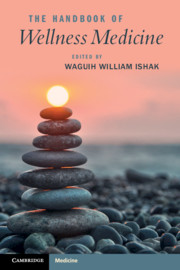Book contents
- The Handbook of Wellness Medicine
- The Handbook of Wellness Medicine
- Copyright page
- Dedication
- Contents
- Contributors
- Part I Approach to Wellness
- Part II From Illness to Wellness by Organ Systems/Disorders
- Chapter 6 The Concept of Wellness in Psychiatric and Substance-Use Disorders
- Chapter 7 Neurological and Neurosurgical Disorders and Wellness
- Chapter 8 Cardiovascular and Pulmonary Wellness
- Chapter 9 Gastrointestinal System and Wellness
- Chapter 10 Wellness and the Genito-Urinary System
- Chapter 11 Reproductive System
- Chapter 12 Allergic, Infectious, and Immunological Processes
- Chapter 13 Wellness in Endocrine and Metabolic Disorders
- Part III Special Populations and Special Topics
- Part IV Wellness Interventions
- Part V Wellness through Optimization of Work, Love, and Play
- Book part
- Index
- References
Chapter 11 - Reproductive System
Pregnancy and Postpartum Wellness
from Part II - From Illness to Wellness by Organ Systems/Disorders
Published online by Cambridge University Press: 18 September 2020
- The Handbook of Wellness Medicine
- The Handbook of Wellness Medicine
- Copyright page
- Dedication
- Contents
- Contributors
- Part I Approach to Wellness
- Part II From Illness to Wellness by Organ Systems/Disorders
- Chapter 6 The Concept of Wellness in Psychiatric and Substance-Use Disorders
- Chapter 7 Neurological and Neurosurgical Disorders and Wellness
- Chapter 8 Cardiovascular and Pulmonary Wellness
- Chapter 9 Gastrointestinal System and Wellness
- Chapter 10 Wellness and the Genito-Urinary System
- Chapter 11 Reproductive System
- Chapter 12 Allergic, Infectious, and Immunological Processes
- Chapter 13 Wellness in Endocrine and Metabolic Disorders
- Part III Special Populations and Special Topics
- Part IV Wellness Interventions
- Part V Wellness through Optimization of Work, Love, and Play
- Book part
- Index
- References
Summary
The focus of this chapter is women’s health and the unique domains of reproductive health and pregnancy. For women to be well, measures to prevent disease and to promote and optimize physical, mental, and social health should be widely adopted. Wellness measures should be consistent across the lifespan of women, from adolescence to reproductive age and into menopause. The roles of preventive health, recognition of disparities and improving health equity, and complementary and alternative medicine in optimizing women’s wellness are reviewed. Lifestyle includes changeable behaviors that can affect the individual’s health in the domains of nutrition, physical activity, stress, self-care, social relationships, and improper health behaviors [1]. Globally the importance of activation of women’s empowerment, social networking, and accountability in women’s health should be considered.
- Type
- Chapter
- Information
- The Handbook of Wellness Medicine , pp. 116 - 134Publisher: Cambridge University PressPrint publication year: 2020
References
- 1
- Cited by

